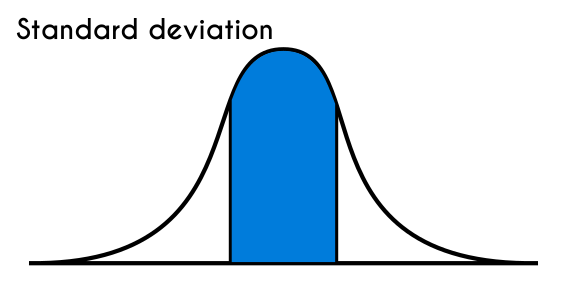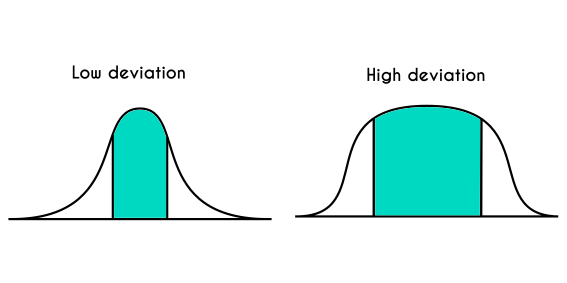Definition of Standard deviation and examples
This article will be about The standard deviation, with solved examples step by step, with the formula.
The standard deviation is a measure of dispersion, that expresses how much do the data of a series data vary respecting from the arithmetic mean. In the standard deviation does not matter if the data is higher or lower than the mean, the only thing that matters is the difference between the average and each data.
The standard deviation is represented by the letter “S” or also with the sigma symbol (σ), the typical deviation is the square root of the variance.

The standard deviation is a complement to the measures of central tendencies, which objective is to find a number that is in the center of the data that represents the data set, so, while the measures of central tendencies works to find a “general” number, the standard deviation is useful to define if the this tendencies is giving an accurate answer.
The problem with the arithmetic mean and with the other measures of central tendencies, is that it is not always reliable, because as we explained in the mean, median and mode article (links at the end of the page), the arithmetic mean is very affected by extremely high numbers and by extremely low numbers, for example, if we have the following data set: {10, 7, 76, 63}, the mean of this data set is 39, but if we compare this average with every element of the set, we can see that none of the numbers is close to the average, so the mean is not that reliable when we want to define the composition of this data set.

The standard deviation is the solution to the previous example, because this defines how reliable is the arithmetic mean, the lowest the standard deviation is, the more reliable is the result, and vice versa.
Formula of the Standard deviation
The standard deviation is calculated by finding the square root of the variance, and to find the variance there are two different formulas, one of them use when we work with a population and the other one is use when we work with a sample. For example, a population could be a class room where there are 45 students, while a sample could be just 10 of the 45 students. So we have to analyze the problem, so we can understand which formula we have to use.
- Formula for a population
- S2 = √ (
Σ (x - x)2 n)
- Formula for a sample
- S2 = √ (
Σ (x - x)2 n - 1)
Examples of standard deviation
Example 1: The ages of the members a curse of french were taken, find the standard deviation of the ages.
{18 , 25 , 21 , 22 , 20 , 20 , 19 , 24}
In this occasion we are working with a population this is why we are going to use the formula of the population.
- First we have to find the mean (x)
- x =
Σ x n
- x =
18 + 25 + 21 + 22 + 20 + 20 + 19 + 24 8
- x =
169 8
- x = 21.13
- Now we find the variance
- S2 =
Σ (x - x) n
- S2 =
(18-21.13)2 + (25-21.13)2 + (21-21.13)2 + (22-21.13)2 + (20-21.13)2 + (20-21.13)2 + (19-21.13)2 + (24-21.13)2 8
- S2 =
(-3.13)2 + (3.87)2 + (-0.13)2 + (0.87)2 + (-1.13)2 + (-1.13)2 + (-2.13)2 + (2.87)2 8
- S2 =
9.80 + 14.97 + 0.017 + 0.76 + 1.28 + 1.28 + 4.53 + 8.24 8
- S2 =
40.87 8
- S2 = 5.11
- And now we can find the standard deviation
- S = √ S2
- S = √ 5.11
- S = 2.26
Example 2: If we want to make a study at a hospital to the patients that arrive at the hospital the poll day, and the question is how many times they got sick during the year, the study will be made out of 4 patients, calculate the standard deviation of the compiled data.
{ 0 , 2 , 1 , 0}
In this problem we are going to use the sample formula of the standard deviation.
- First we find the mean (x)
- x =
Σ x n -1
- x =
0 + 2 + 1 + 0 4
- x =
3 4
- x = 0.75
- Now we find the variance
- S2 =
Σ (x - x) n-1
- S2 =
(0 - 0.75)2 + (1 - 0.75)2 + (2 - 0.75)2 + (0 - 0.75)2 4 -1
- S2 =
(-0.75)2 + (0.25)2 + (1.25)2 + (-0.75)2 3
- S2 =
0.56 + 0.063 + 1.56 + 0.56 3
- S2 =
2.74 3
- S2 = 0.91
- And now we calculate the standard deviation
- S = √ S2
- S = √ 0.91
- S = 0.956
Example 3: A poll was made to a group of work where they asked a part of the group to evaluate the boss on a scale from 1 to 10 and the results were:
{ 7 , 8 , 7 , 5 , 8}
Knowing these calculate the standard deviation of the results.
- First we calculate the mean (x)
- x =
7+8+7+5+8 5
- x =
35 5
- x = 7
- Then we calculate the variance
- S2 =
Σ (x - x) n-1
- S2 =
(7 - 7)2 + (8 - 7)2 + (7 - 7)2 + (5 - 7)2 + (8 - 7)2 5 -1
- S2 =
02 + 12 + 02 + (-2)2 + 12 4
- S2 =
1 + 4 + 1 4
- S2 =
6 4
- S2 = 1.5
- Now knowing the variance, we define the standard deviation
- S = √ S2
- S = √ 1.5
- S = 1.22